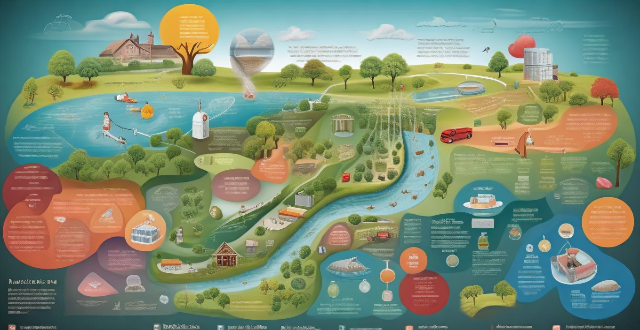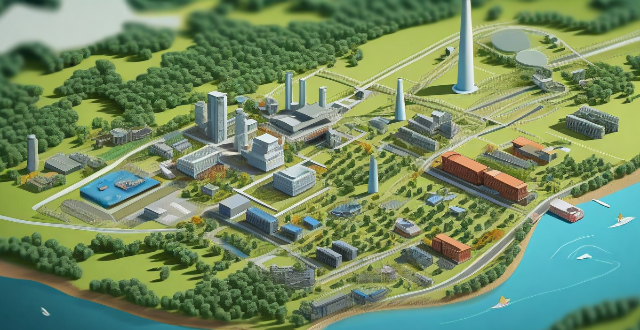Impact Environment

How does a Series Hybrid Electric Vehicle impact the environment ?
Series hybrid electric vehicles (SHEVs) have a positive impact on the environment through reduced emissions and improved fuel efficiency. However, challenges such as battery production and waste management must be addressed to maximize their environmental benefits. The overall impact also depends on factors like the source of electricity for charging and vehicle design efficiency.

How do scientists use climate models to study the impact of human activities on the environment ?
Climate models are mathematical tools used to simulate the Earth's climate system and study the impact of human activities on the environment. The process involves data collection, model construction, scenario analysis, prediction and projection, and continuous validation and refinement. These models help policymakers make informed decisions about reducing greenhouse gas emissions and adapting to climate change.

How does climate data analysis aid in understanding the impact of human activities on the environment ?
Climate data analysis aids in understanding the impact of human activities on the environment by identifying climate change indicators, analyzing atmospheric composition, monitoring land use changes, assessing water resources, and evaluating energy consumption. By collecting and analyzing various types of climate data, scientists can identify patterns and trends that help them understand how human activities are affecting the planet. This information is critical for developing strategies to mitigate the negative impacts of human activities on the environment and promote sustainable development.

How do human activities impact the environment and what ethical responsibilities do we have ?
Summary: Human activities such as pollution, deforestation, overfishing, and climate change have a significant negative impact on the environment. To fulfill our ethical responsibility towards the environment, we should reduce, reuse, recycle, support sustainable practices, advocate for environmental protection, and educate others about the importance of preserving the planet for future generations.

How do agricultural practices impact the environment ?
Agriculture is a vital sector for human survival, but its practices can have significant impacts on the environment. Deforestation and land use changes, water pollution, air pollution, soil degradation, energy consumption, and loss of biodiversity are all potential negative effects of agriculture. However, adopting sustainable practices such as conservation tillage, integrated pest management, precision farming techniques, and diversified cropping systems can minimize these impacts while maintaining agricultural productivity. It is crucial for farmers, policymakers, and consumers to prioritize environmentally friendly agricultural practices to ensure a sustainable future.

Is it ethical to continue using fossil fuels given their negative impact on the environment ?
The text discusses the ethical implications of continuing to use fossil fuels given their negative impact on the environment. It highlights the harmful pollutants released by burning fossil fuels, including carbon dioxide, sulfur dioxide, nitrogen oxides, and particulate matter. These pollutants contribute to global warming, acid rain, and air pollution, which have negative effects on human health, biodiversity, and the environment. The text suggests that we have a moral obligation to protect the environment for future generations and raises questions about environmental justice and equity. However, some argue that transitioning away from fossil fuels would be too costly and disruptive to economies around the world. The text also explores alternatives to fossil fuels, such as solar power, wind power, hydropower, geothermal energy, and biomass. In conclusion, the text argues that it is ethically questionable to continue using fossil fuels as our primary source of energy and that we should focus on developing and implementing cleaner, renewable sources of energy to mitigate our impact on the environment.

How do distributed energy systems impact the environment ?
Distributed energy systems, characterized by their clean and efficient nature, play a crucial role in modern energy systems. These systems primarily utilize renewable energy sources such as solar, wind, and biomass, and are typically located near energy consumers. This not only reduces transmission losses but also enhances the overall efficiency of energy utilization. The impact of distributed energy systems on the environment can be broadly categorized into the following key points: 1. **Reducing Greenhouse Gas Emissions** - **Decrease Fossil Fuel Dependence**: Distributed energy systems often use renewable energy sources, reducing the need for fossil fuels and thereby decreasing greenhouse gas emissions associated with traditional power generation. - **Promote Energy Diversification**: By combining various renewable sources, these systems help diversify energy production, further mitigating the environmental impact of energy reliance on any single source. 2. **Enhancing Energy Utilization Efficiency** - **Decentralized Production**: Producing energy closer to where it is consumed reduces transmission losses that occur in centralized power systems. - **Combined Heat Power**: Some distributed systems employ combined heat and power (CHP) technology, which can achieve higher energy efficiency rates, up to 80%-90%, compared to traditional methods. 3. **Mitigating Environmental Pollution** - **Reduction in Exhaust Emissions**: Renewable distributed energy sources like solar and wind inherently produce no emissions, significantly reducing air pollution compared to fossil fuel combustion. - **Minimizing Water Pollution**: Unlike some large-scale hydroelectric projects, distributed renewable sources have a minimal impact on water ecosystems and do not introduce pollutants into water bodies. 4. **Promoting Sustainable Development** - **Sustainable Resource Cycles**: Distributed systems often incorporate local energy cycles, promoting sustainable resource use and management at a community level. - **Eco-friendly Infrastructure**: The infrastructure required for distributed energy systems, such as solar panels and wind turbines, has a relatively lower environmental footprint compared to traditional power plants. 5. **Improving Ecological Biodiversity** - **Land Use Impact**: Distributed energy projects generally require less land compared to large-scale power plants, thus having a reduced impact on habitats and biodiversity. - **Habitat Preservation**: The decentralized nature of these systems allows for easier integration into existing environments without significantly disrupting ecological balance. 6. **Increasing Systemic Resilience** - **Disaster Response**: Decentralized energy systems can continue to operate even when the main grid fails, enhancing community resilience during natural disasters or other crises. - **Grid Stability**: Distributed energy resources can help stabilize the electrical grid by providing localized load balancing and peak shaving functions. 7. **Supporting Policy and Regulations** - **Policy Driving Forces**: Many governments encourage the development of distributed energy through favorable policies, aiming to reduce carbon emissions and promote sustainable development. - **Regulatory Frameworks**: Comprehensive regulatory frameworks ensure that the development of distributed energy aligns with environmental protection and sustainability goals. Additionally, while distributed energy systems offer numerous environmental benefits, careful planning and implementation are necessary to maximize their positive impacts. For instance, the extraction and processing of materials for solar panels and wind turbines can have environmental costs, necessitating strict oversight and environmentally friendly practices. Moreover, integrating distributed energy effectively into existing energy frameworks requires advanced grid management technologies and innovative market mechanisms.

How does electronic waste affect the environment if not recycled ?
Electronic waste, or e-waste, refers to discarded electronic devices such as computers, smartphones, and televisions. Improper disposal of these items can have severe consequences for the environment, including the release of toxic chemicals into soil, water, and air. These chemicals can cause health problems for both humans and wildlife. Non-recycled e-waste also occupies valuable landfill space and contributes to soil contamination, water pollution, and air pollution. Proper recycling of electronic waste is essential to protect the environment and human health, conserve natural resources, and minimize the impact on landfills.

What are the long-term effects of plastic pollution on the environment ?
The article discusses the long-term effects of plastic pollution on the environment, including soil degradation, impact on aquatic ecosystems, harm to wildlife, human health risks, and economic impact. It emphasizes the need for collective efforts to reduce plastic consumption and properly dispose of waste to protect the planet.

How does climate change affect children's rights to a healthy environment ?
This article explores the impact of climate change on children's right to a healthy environment, highlighting various health, nutritional, psychological, and educational implications. It emphasizes that addressing climate change is crucial for safeguarding children's rights and future well-being.

How does global shopping impact the environment ?
Global shopping, facilitated by the internet and globalization, has a significant impact on the environment. Topics include increased carbon emissions from transportation, deforestation for materials like palm oil, water pollution from industrial runoff, high energy consumption in data centers and manufacturing, and poor labor practices. Consumers can reduce their environmental impact by being conscious of their purchases and supporting companies with sustainable practices.

What is the optimal environment for studying effectively at home ?
The provided text offers a comprehensive guide on creating an optimal study environment at home. It emphasizes the importance of choosing a quiet area with comfortable seating and adequate lighting. The text suggests keeping the study area clean, clutter-free, and properly organized with essential materials within reach. It also recommends minimizing distractions by controlling electronics, using do not disturb signs, and scheduling short breaks. Personalizing the space with motivational decor, personal touches, and maintaining a comfortable temperature is also advised. Overall, the text aims to help readers create a conducive study environment that enhances focus and productivity.

How does wind energy affect the environment ?
Wind energy is a renewable source of power that has become increasingly popular as an alternative to fossil fuels. However, like any form of energy production, it does have some environmental impacts. The positive effects of wind energy on the environment include a reduction in greenhouse gas emissions, conservation of natural resources such as water and no need for fuel. Wind farms can coexist with agricultural activities and modern turbine designs can help minimize impacts on local wildlife. However, there are also potential negative effects on the environment. These include visual and noise pollution, as well as potential impacts on wildlife such as bird and bat collisions and habitat disruption. The presence of large structures like wind turbines can also alter local wind patterns and potentially affect microclimates. Overall, while wind energy offers significant benefits in terms of reducing greenhouse gas emissions and conserving natural resources, it is not without its challenges regarding visual and noise pollution, as well as potential impacts on wildlife. Careful planning and technological advancements can help mitigate these negative effects, making wind energy an increasingly viable option for a sustainable future.

What impact does sustainable investing have on the environment ?
##Impact of Sustainable Investing on the Environment Sustainable investing, also known as responsible or green investing, is an investment strategy that focuses on companies and projects that have a positive impact on the environment and society. This type of investing has become increasingly popular in recent years as investors become more aware of the environmental and social impacts of their investments. The following are some of the ways sustainable investing can have a positive impact on the environment: ### Reduction in Carbon Emissions One of the most significant impacts of sustainable investing is the reduction in carbon emissions. Companies that prioritize sustainability often use renewable energy sources such as solar, wind, and hydro power to generate electricity. This reduces their reliance on fossil fuels, which are major contributors to greenhouse gas emissions. By investing in these companies, investors can help reduce carbon emissions and combat climate change. ### Conservation of Natural Resources Sustainable investing also promotes the conservation of natural resources. Companies that prioritize sustainability often implement practices that reduce waste, conserve water, and protect biodiversity. For example, they may use recycled materials in their products or implement water-saving technologies in their operations. By investing in these companies, investors can help conserve natural resources and protect ecosystems. ### Promotion of Clean Energy Sustainable investing encourages the development and adoption of clean energy technologies. Companies that prioritize sustainability often invest in research and development of new clean energy technologies such as electric vehicles, battery storage systems, and smart grids. By investing in these companies, investors can help drive innovation and accelerate the transition to a low-carbon economy. ### Support for Environmental Regulations Finally, sustainable investing supports the implementation of environmental regulations and policies. Companies that prioritize sustainability often comply with strict environmental regulations and support policies that promote sustainability. By investing in these companies, investors can help create a regulatory environment that encourages businesses to operate sustainably and protect the environment.

How do building energy efficiency standards impact the environment ?
**Summary:** Building energy efficiency standards positively impact the environment by reducing greenhouse gas emissions, conserving natural resources, enhancing air quality, and promoting energy innovation. These standards lead to more energy-efficient buildings, reduced dependence on fossil fuels, cleaner air, and advancements in sustainable technologies.

How does clean energy investment impact the environment ?
Clean energy investment positively affects the environment in various ways, including reducing greenhouse gas emissions, conserving natural resources, improving air quality, promoting sustainable practices, and enhancing long-term energy security. These efforts help mitigate climate change, protect ecosystems, reduce pollutants, encourage innovation and job creation, and stabilize energy prices. As environmental challenges persist, prioritizing clean energy investment is crucial for the planet's health and future generations.

How can a company's culture impact workplace safety ?
The text discusses the significant role of company culture in shaping workplace safety. It highlights five key aspects of a company's culture that can impact safety, including effective communication and collaboration, leadership and accountability, training and education, respectful and inclusive environment, and continuous improvement. The article emphasizes the importance of fostering a work environment where employees feel comfortable sharing information, leaders set clear expectations, regular training is provided, mutual respect is promoted, and continuous improvements are made based on feedback and data analysis. Overall, the article underscores the need for organizations to prioritize these cultural elements to create a safer work environment for their employees.

How do electric transportation systems impact the environment ?
Electric transportation systems, primarily represented by electric vehicles (EVs), have a significant impact on the environment. The environmental implications of EVs include: 1. **Reduction in Greenhouse Gas Emissions**: Compared to traditional internal combustion engine (ICE) vehicles, EVs can effectively reduce CO2 emissions over their entire life cycle by approximately 18% to 42%. This reduction is further enhanced as the power generation sector becomes cleaner. 2. **Improvement in Air Quality**: EVs do not produce tailpipe emissions, leading to significant reductions in urban air pollutants like NOx and PM 2.5. This decrease in air pollution translates to notable health benefits, such as reduced cases of premature death from airborne particles. 3. **Impact of Battery Production**: Battery manufacturing for EVs currently involves high energy consumption and emissions, especially during the extraction and processing of raw materials. Mining activities for battery materials can cause ecological damage and social issues in mining regions. 4. **Changes in Energy Consumption**: EVs shift energy demand from petroleum to electricity, affecting overall energy consumption patterns. They generally offer better energy efficiency compared to ICE vehicles, reducing overall energy requirements for transportation. 5. **Influence on Power Generation Sector**: The growth of EVs increases the demand for electricity, which may affect the mix of power generation unless met by renewable sources. However, EVs can potentially support the integration of renewable energy sources through smart charging technologies. 6. **Waste and Recycling**: Proper recycling and secondary use of EV batteries can significantly reduce associated environmental impacts. By adopting circular economy principles, the industry can minimize waste and reuse valuable materials from spent batteries. 7. **Infrastructure Needs**: The expansion of EV usage necessitates the development of a substantial charging infrastructure, which itself carries environmental impacts. Ensuring that charging infrastructure is powered by renewable energy sources can mitigate its environmental footprint. To enhance the environmental performance of EVs, strategies such as promoting renewable energy development, implementing battery recycling programs, and adopting smart charging solutions should be considered. These actions will help ensure that electric transportation systems make a positive contribution to environmental sustainability.

How do climate change and environmental factors impact virus origin tracing ?
Climate change and environmental factors play a significant role in virus origin tracing by affecting host and vector distribution, human activities, and interactions with the environment. Understanding these impacts is crucial for effective surveillance and research efforts to prevent and control infectious diseases.

How can I create an environment that encourages creative expression ?
Creating an environment that encourages creative expression is essential for fostering innovation, personal growth, and problem-solving skills. Here are some tips on how to create such an environment: 1. Set the tone by making everyone feel comfortable sharing their ideas and opinions without fear of judgment or criticism. 2. Provide opportunities for self-expression through various forms of media, such as writing, drawing, music, or dance. 3. Foster collaboration by encouraging teamwork and brainstorming sessions where everyone feels valued and heard. 4. Create a safe space where people feel comfortable taking risks and making mistakes. 5. Offer incentives and recognition to motivate individuals to continue exploring their imagination. 6. Provide resources and tools that support creative expression, such as art supplies, software, or access to workshops and training programs. 7. Encourage time for reflection and inspiration by providing regular breaks, mindfulness exercises, or a quiet space for contemplation. 8. Promote diversity and inclusion to encourage different perspectives and ideas, leading to more creative solutions.

How do biosafety policies impact the research and development of new drugs and vaccines ?
Biosafety policies play a crucial role in drug and vaccine development by promoting safety, protecting public health, preserving the environment, and fostering scientific progress. These policies provide guidelines for handling hazardous materials, maintaining a clean laboratory environment, and preventing accidental exposure or contamination. By adhering to these standards, researchers can work more safely and effectively, reducing the risk of accidents or injuries that could slow down or halt their work. Additionally, biosafety policies help protect public health during clinical trials, minimize the risk of adverse reactions or side effects, and ensure that any new drugs or vaccines are safe before they reach the market. Biosafety policies also govern the disposal of hazardous waste materials and prevent accidental spills or releases of dangerous substances, protecting the environment from long-lasting harm. Finally, these policies promote collaboration and information sharing among researchers, leading to faster and more efficient drug and vaccine development while ensuring that research findings are reliable and reproducible.

What is the impact of greenhouse gas emissions on the environment ?
The impact of greenhouse gas emissions on the environment includes climate change, air pollution, and ocean acidification. Climate change leads to rising temperatures, melting ice caps, and extreme weather events. Air pollution causes respiratory and cardiovascular diseases, while ocean acidification harms coral reefs and disrupts marine ecosystems. Reducing reliance on fossil fuels is crucial to mitigate these effects.

How does PPE contribute to creating a safe work environment ?
PPE's Role in Creating a Safe Work Environment Personal Protective Equipment (PPE) is vital for establishing a safe work environment by providing a physical barrier between workers and potential hazards, reducing the risk of injuries and illnesses. PPE contributes to safety in various ways, including preventing direct contact with hazardous substances, reducing exposure to harmful agents, providing physical support and protection, enhancing visibility and awareness, promoting compliance with regulations, encouraging responsible behavior, and contributing to ergonomic well-being. By implementing and maintaining the use of PPE, employers can significantly reduce the number of work-related injuries and illnesses, creating a safer and more secure work environment for all employees.

What impact will super fast charging stations have on the environment ?
The article discusses the potential environmental impacts of super fast charging stations for electric vehicles. It highlights concerns such as increased energy consumption, battery degradation, land use and urban sprawl, and noise pollution. The article emphasizes the importance of using renewable sources of electricity, implementing proper battery recycling programs, considering land use and urban sprawl issues, and addressing noise pollution concerns to minimize these impacts.

What is the impact of communication base stations on wildlife and the environment ?
The text discusses the impact of communication base stations on wildlife and the environment. The main concerns are electromagnetic radiation, noise pollution, habitat loss and fragmentation. Electromagnetic radiation can have negative health effects on certain species and disrupt their behavior. Noise pollution can disturb sleep patterns and mask important sounds used by animals for communication and predator detection. Habitat loss and fragmentation can lead to reduced genetic diversity within populations and increased vulnerability to diseases and predators. However, there are measures that can be taken to minimize these impacts, such as careful site selection, landscape design, noise reduction, and ongoing research and monitoring.

How can we reduce the impact of climate change on the environment ?
To mitigate the effects of climate change, it is crucial that individuals, communities, and governments take action to reduce the impact of climate change on the environment. Some strategies for doing so include reducing greenhouse gas emissions by switching to renewable energy sources and improving energy efficiency, protecting and restoring ecosystems such as forests, wetlands, and grasslands, promoting sustainable land use practices in agriculture and urban planning, encouraging circular economy practices like reducing, reusing, and recycling materials, and supporting clean transportation options like public transit and electric vehicles. These efforts can lead to significant reductions in greenhouse gas emissions and make a positive difference for future generations.

What are some examples of negative impacts of tourism on the environment ?
Tourism can have negative impacts on the environment, including destruction of natural habitats, pollution, overuse of resources, cultural impacts, physical degradation, and contributing to climate change. It is important to manage tourism sustainably to minimize these effects and preserve the planet's natural beauty for future generations.

How can parents create a positive learning environment through home teaching strategies ?
Creating a positive learning environment at home is crucial for children's academic success and overall well-being. Here are some strategies parents can use to foster such an atmosphere: 1. Establish a dedicated learning space that is quiet, organized, and comfortable. 2. Set clear expectations and goals with your child, and celebrate their achievements to boost confidence and motivation. 3. Foster a love for learning by encouraging curiosity, introducing new materials, and leading by example. 4. Provide support and encouragement by offering help when needed, praising effort over outcomes, and fostering a growth mindset. By implementing these strategies, parents can create a positive learning environment that encourages curiosity, exploration, and continuous growth for their children.

What is the impact of climate decisions on future generations ?
This text discusses the far-reaching impacts of climate decisions on future generations, including environmental issues such as rising sea levels and loss of biodiversity, economic shifts related to job markets and infrastructure costs, and societal effects like health concerns and political stability. It emphasizes the importance of taking immediate action to mitigate these impacts and create a sustainable future for all.